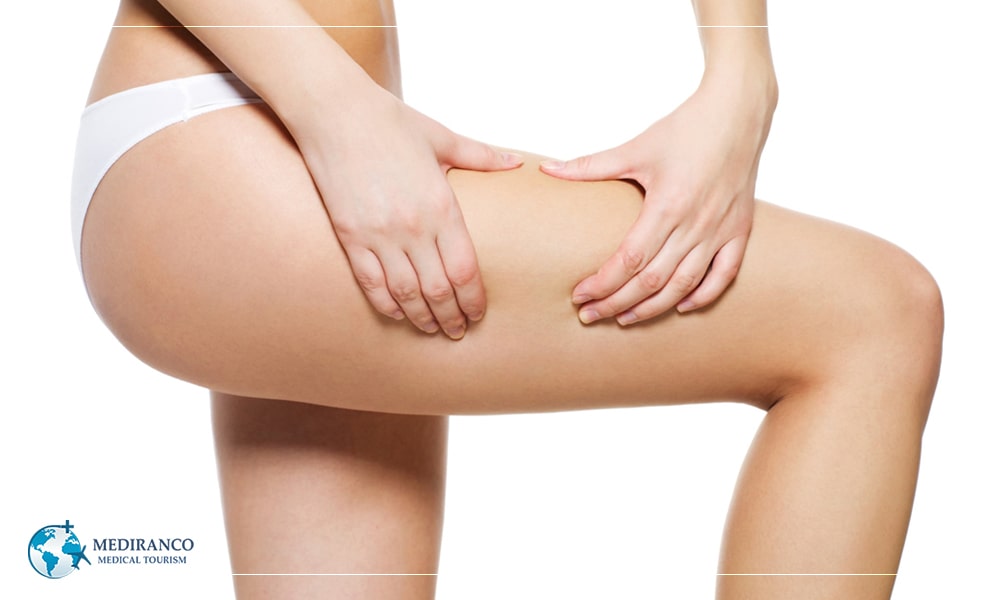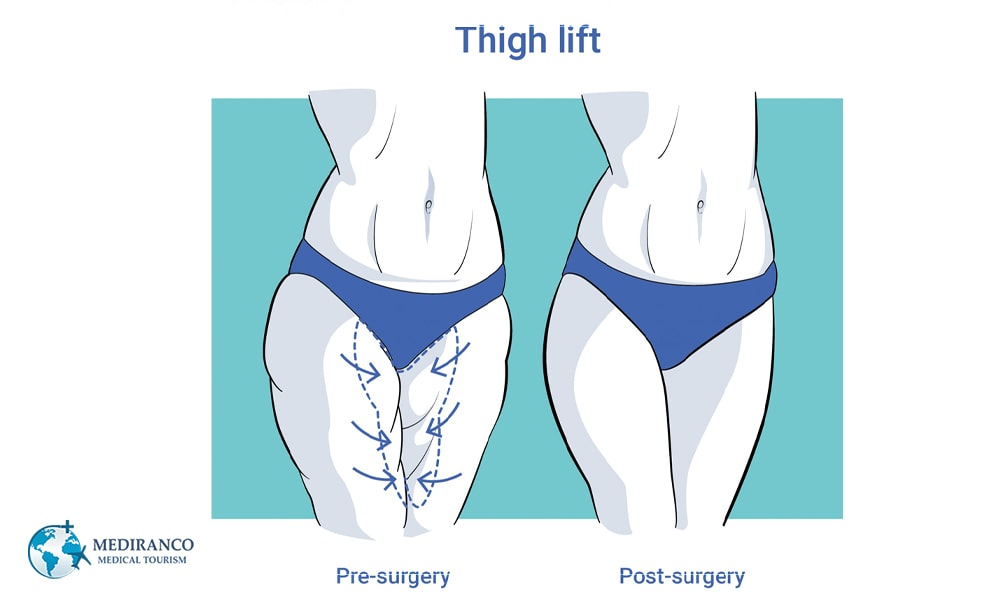Who is a good candidate for thigh lift? A thigh lift, also known as thighplasty, is a cosmetic surgical procedure designed to improve the appearance of the thighs. This procedure is typically sought by individuals who are dissatisfied with the shape, contour, or excess skin and tissue in their thigh area. In this article we will discuss in details the definition of thigh lift and who may benefit from it.
- Understanding Thigh Lift Surgery
- Who is a good candidate for thigh lift?
- Consultation and Considerations
- Final Words
- FAQ
Table of Contents
ToggleUnderstanding Thigh Lift Surgery
Thigh lift surgery, also known as thighplasty, is a cosmetic surgical procedure designed to reshape and improve the appearance of the thighs. This procedure is typically sought by individuals who have excess skin and fat in the thigh area due to factors such as aging, significant weight loss, or genetics.
The primary goal of thigh lift surgery is to create a smoother, more toned, and youthful contour of the thighs. There are several different techniques used in thigh lift surgery, and the choice of technique depends on the patient’s unique anatomy and aesthetic goals. Here are some key aspects of thigh lift surgery:
Types of Thigh Lift Procedures:
- Medial Thigh Lift: This targets the inner thighs and is suitable for those with excess skin and fat in this area.
- Lateral Thigh Lift: Focuses on the outer thighs and can address sagging skin and tissue on the sides of the legs.
- Bilateral Thigh Lift: Involves both the inner and outer thighs, providing comprehensive thigh reshaping.
Thigh Lift Procedure Steps
- Anesthesia: Thigh lift surgery is typically performed under general anesthesia to ensure the patient’s comfort and safety.
- Incisions: Incision patterns may vary depending on the specific technique used. Common incisions are made in the groin area, extending down the inner thigh or along the bikini line.
- Removal of Excess Tissue: The surgeon removes excess skin and fat from the targeted areas.
- Skin Tightening: The remaining skin is pulled taut and sutured to create a smoother, more contoured appearance.
- Recovery: Recovery time can vary, but patients may need to limit physical activity for a few weeks and wear compression garments to aid in healing.
Thigh lift risks
- As with any surgical procedure, there are risks involved, including infection, scarring, and anesthesia-related complications.
- Swelling and bruising are common after surgery, but these typically subside over time.
- Patients should follow post-operative instructions carefully to minimize complications.
Thigh lift surgery can provide significant improvements in thigh appearance and self-confidence. However, it’s essential to consult with a board-certified plastic surgeon to assess whether you are a suitable candidate for the procedure and to discuss your expectations and potential outcomes. It’s also crucial to have realistic expectations about the results, as the final outcome may take several months to fully manifest, and individual results can vary.
Who is a good candidate for thigh lift?

Thigh lift surgery can be beneficial for individuals who are bothered by the appearance of their thighs due to excess skin, fat, or sagging tissue. Here are some groups of people who may benefit from thigh lift surgery:
- Weight Loss Patients: Many individuals who have lost a significant amount of weight, either through diet and exercise or bariatric surgery, often face the challenge of excess skin and tissue in various body areas, including the thighs. Thigh lift surgery can help contour and tighten the thighs after substantial weight loss, improving overall body proportions.
- Aging and Sagging Skin: As we age, our skin loses elasticity, leading to sagging and laxity in various areas, including the thighs. Thigh lift surgery can address this natural aging process by removing excess skin and providing a more youthful and toned appearance.
- Genetics and Body Shape: Some individuals may have a genetic predisposition to accumulate excess fat and skin in the thigh area. These genetic factors can make it difficult to achieve the desired thigh shape through diet and exercise alone. Thigh lift surgery can help reshape the thighs and enhance body proportions.
- Post-Pregnancy Changes: Pregnancy can cause significant changes in a woman’s body, including excess fat deposits and stretched skin in the thigh area. A thigh lift can be part of a post-pregnancy makeover to restore a more youthful and toned appearance.
- Boosting Self-Confidence: Individuals who are self-conscious about the appearance of their thighs may experience improved self-esteem and body confidence after thigh lift surgery. This procedure can help individuals feel more comfortable wearing shorts, swimsuits, or form-fitting clothing.
- Physical Discomfort: Excess skin and tissue in the thigh area can lead to physical discomfort and skin irritation. Thigh lift surgery can alleviate these discomforts by removing excess skin and fat.
It’s important to note that while thigh lift surgery can provide significant aesthetic and psychological benefits, it is not a substitute for weight loss or a healthy lifestyle. Candidates for thigh lift surgery should be at a stable weight and in good overall health. Additionally, patients should have realistic expectations about the outcomes of the procedure and be committed to following post-operative care instructions to ensure a successful recovery. Consulting with a board-certified plastic surgeon is crucial to determine whether thigh lift surgery is the right option for one’s individual needs and goals.
Consultation and Considerations
A thorough consultation is a critical initial step for anyone considering thigh lift surgery (thighplasty). This consultation allows both the patient and the plastic surgeon to discuss expectations, assess candidacy, and address any concerns. Here are key considerations during a thigh lift consultation:
- Medical History: Discuss your medical history, including previous surgeries and current medications.
- Physical Examination: The surgeon will assess your thighs and surrounding areas to determine candidacy and the appropriate technique.
- Expectations and Goals: Share your aesthetic goals and ensure they align with what can be achieved with thigh lift surgery.
- Procedure Options: Learn about the available thigh lift techniques and which one suits your anatomy and goals.
- Risks and Complications: Understand potential surgical risks and complications, including infection, scarring, and bleeding.
- Recovery: Discuss the recovery process, including limitations, compression garment use, and follow-up appointments.
- Questions and Concerns: Feel free to ask any questions or express concerns to gain a better understanding of the procedure.
- Pre-operative Instructions: Learn about pre-surgery instructions, such as medication adjustments, fasting, and smoking cessation.
- Aftercare: Understand post-operative care, incision care, pain management, and how to recognize potential complications.
Streamlining these considerations can help facilitate a comprehensive thigh lift consultation while keeping the focus on essential aspects of the procedure.
Final Words

Who is a good candidate for thigh lift? In conclusion, a thigh lift is a cosmetic surgical procedure designed to address issues related to excess skin, fat, and sagging tissue in the thigh area. It can be a transformative solution for individuals who have struggled with these concerns due to factors such as significant weight loss, aging, genetics, or pregnancy. By removing excess skin and fat and reshaping the thighs, a thigh lift can enhance both the aesthetics and comfort of the lower body.

Thigh Lift in Iran
Mediranco Health Tourism Company offers exceptional medical tourism services, providing top-quality healthcare solutions and personalized assistance for a wide range of treatments.

